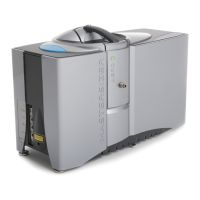Maintenanc e
94
Internal diameter External diameter Wall thickness
3/16"
(4.8 mm)
5/16"
(8.0 mm)
1/16"
(1.6 mm)
Cleaning the covers
Caution!
The surfaces of the system may be permanently damaged if samples or dis-
persants are spilled on them. If a spillage occurs, disconnect the system from
the power supply before you begin to clean.
l Periodically clean the covers thoroughly with a mild soap solution.
l Never clean with excessive liquid and always avoid electrical components (con-
nectors, etc.) and the cell windows.
l Never clean with a solvent based solution; it may damage the surface.
Performing a Quality Audit Standard measurement
Malvern supplies a Quality Audit Standard (QAS) specifically designed to test the per-
formance of the dispersion unit. It is recommended this is performed at least once a week
or as an internal quality procedure.
The QAS is supplied with instructions to enable the measurement to be easily followed
and performed.
Contact Malvern Instruments for more information.
Power connection, leads and fuses
Power is supplied to the Mastersizer 3000 dispersion units via the CAN cable from the
Mastersizer 3000 optical unit. This cable supplies both power and communications for
the dispersion unit.
Consult the Mastersizer 3000 User Manual and Basic Guide for maintenance information
on the optical unit and power connections.

